Introduction
Coloring pages are a fantastic way to engage kids in creative activities, offering them a chance to express their artistic side while also improving their motor skills and focus. One particularly delightful subject for coloring is the robin, a charming and iconic bird known for its bright red chest and melodious song. In this blog post, we present a curated selection of 20 robin coloring pages designed to captivate and entertain children of various ages. These pages feature a range of robin illustrations, from realistic depictions to whimsical, cartoonish renditions, providing ample opportunities for creativity and fun.
Why Choose Robin Coloring Pages?
Robins are not only visually appealing with their vibrant colors, but they also hold a special place in many cultures and seasons. Their presence often signifies the arrival of spring and renewal, making them an excellent choice for a range of themed activities. By coloring robin illustrations, children can learn more about this beloved bird while honing their artistic skills.
Age Range: Who Can Enjoy These Coloring Pages?
Robin coloring pages are suitable for a wide age range of children. Here’s a quick breakdown of who might enjoy these pages:
Toddlers (Ages 2-4)
For toddlers, simple and bold robin illustrations are ideal. At this stage, children are developing their fine motor skills and hand-eye coordination. Coloring pages with large, clear lines and less intricate details allow toddlers to practice these skills without getting overwhelmed.
Preschoolers (Ages 4-6)
Preschoolers will benefit from robin coloring pages that feature slightly more detailed images. These can include playful and cartoonish robins, which are perfect for their developing creativity and imagination. Coloring these pages helps enhance their color recognition and decision-making skills.
Early Elementary (Ages 6-8)
Children in early elementary grades can tackle more complex robin illustrations. These pages may include a mix of realistic and stylized robins, offering a greater challenge and allowing for more artistic freedom. This age group enjoys adding their own personal touches and experimenting with different coloring techniques.
Older Kids (Ages 8+)
Older kids and pre-teens can handle highly detailed robin coloring pages. These might include intricate patterns and more realistic depictions of robins in various environments. This level of detail not only provides a satisfying challenge but also encourages patience and attention to detail.
Facts About Robin
Here are some interesting facts about robins that can be shared with kids while they color:
- Appearance: Robins are known for their distinctive red or orange chests, brownish-gray wings and backs, and white bellies. Their bright colors make them easy to spot and a favorite subject for artists.
- Habitat: Robins are common in North America, Europe, and parts of Asia. They can often be seen in gardens, parks, and woodlands.
- Diet: Robins primarily eat insects, worms, and berries. They are known for their excellent foraging skills and keen eyesight, which help them find food.
- Behavior: Robins are known for their melodious songs, especially during the breeding season. Their songs can vary regionally and are often used to attract mates or mark territory.
- Migration: Many robins are migratory, traveling south to warmer regions in winter and returning to their breeding grounds in spring.
- Nesting: Female robins build their nests from grass, mud, and twigs, usually in trees or shrubs. They lay a clutch of blue eggs, which they incubate for about two weeks.
- Cultural Significance: In various cultures, robins are symbols of renewal and new beginnings, often associated with the arrival of spring.
- Lifespan: The average lifespan of a robin in the wild is about 2 years, though some can live up to 5 years or more.
- Adaptability: Robins are adaptable birds and can thrive in a range of environments, from urban areas to rural landscapes.
- Family Life: Robins are known for their strong family bonds. Both parents are involved in raising the young, with the male often singing to protect their territory and attract food.
Explore 20 Robin Coloring Pages For Kids
Robin Coloring Page 1 for Kids

Robin Coloring Page 2 for Kids

Robin Coloring Page 3 for Kids

Robin Coloring Page 4 for Kids

Robin Coloring Page 5 for Kids

Robin Coloring Page 6 for Kids

Robin Coloring Page 7 for Kids

Robin Coloring Page 8 for Kids

Robin Coloring Page 9 for Kids

Robin Coloring Page 10 for Kids

Robin Coloring Page 11 for Kids

Robin Coloring Page 12 for Kids

Robin Coloring Page 13 for Kids

Robin Coloring Page 14 for Kids

Robin Coloring Page 15 for Kids

Robin Coloring Page 16 for Kids

Robin Coloring Page 17 for Kids

Robin Coloring Page 18 for Kids

Robin Coloring Page 19 for Kids

Robin Coloring Page 20 for Kids









Maze Rampage Kids Activity Books: Unlock Fun and Learning for Toddlers and Preschoolers!
Engage Your Creative Mind with 2,500+ Free Adult Coloring Pages
100 Wasp Coloring Pages For Kids
48 Termite Coloring Pages For Kids